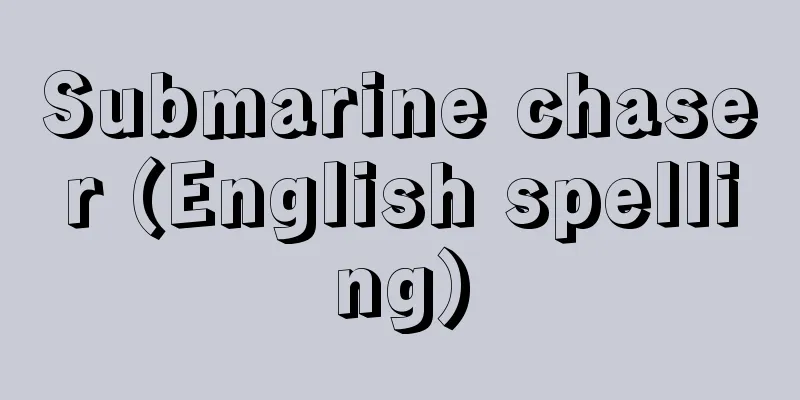Submarine chaser (English spelling)

|
A small anti-submarine vessel with a displacement of 500 to 600 tons or less, whose main duties are patrolling ports, coasts, and straits, and guarding against, searching for, and attacking invading submarines. Most have a speed of around 20 knots, but some recent high-speed vessels can exceed 30 knots. The first were patrol boats (P boats and PC boats) hastily built by the UK to counter German submarine attacks during World War I, and Eagle boats and small submarine chasers (SC boats), which were similar to the P boats mass-produced by the US. Other countries, including Japan, began building them between the First and Second World Wars, but in Japan, the Type 13 and Type 28 submarine chasers (standard displacement 420 to 438 tons, speed 16 knots, equipped with 36 depth charges), which were built in large numbers from just before and during World War II, were representative of large steel boats of the time. Early boats were equipped with hydrophones for reconnaissance and depth charges and small caliber guns for offensive weapons, but were later equipped with underwater detectors (sonars). During World War II, some boats were equipped with forward-throwing anti-submarine weapons for offensive purposes, and after the war, homing torpedoes replaced depth charges. However, the dramatic improvement in the performance of submarines after the war made it difficult for conventional boats to respond. As a result, high-speed boat types and hydrofoil types using high-speed diesel engines and gas turbines as their main engines were built, but recently, small corvettes, which have higher performance and better weapon carrying capacity, have been used for local anti-submarine missions instead of submarine chasers. [Yasuo Abe] [References] | | | |Source: Shogakukan Encyclopedia Nipponica About Encyclopedia Nipponica Information | Legend |
|
主として港湾、沿岸、海峡などの哨戒(しょうかい)、侵入潜水艦に対する警戒・捜索・攻撃などを主任務とする、排水量500~600トン以下の小型対潜艦艇。速力20ノット程度のものが主流だが、最近の高速艇タイプには30ノットを超すものもある。第一次世界大戦時に、ドイツの潜水艦攻撃に対抗して、イギリスが急いで建造した哨戒艇(PボートおよびPCボート)、アメリカが量産したPボートに類似したイーグル・ボートおよび小型駆潜艇(SCボート)が最初のもの。第一次、第二次世界大戦戦間期に、日本を含めた各国も建造を始めたが、日本では、第二次世界大戦直前から戦時中に多数建造した第13号型および第28号型駆潜艇(基準排水量420~438トン、速力16ノット、爆雷36個搭載)が、当時の鋼製大型艇の代表的なものであった。初期の艇では、索敵兵器に水中聴音機、攻撃兵器に爆雷と小口径砲が搭載されていたが、その後、水中探知機(ソナー)が装備された。第二次世界大戦中には攻撃用として前投対潜兵器を備えた艇も出現、大戦後は、爆雷にかわってホーミング魚雷が装備された。しかし、大戦後の潜水艦の性能の飛躍的向上により、在来型の艇では対応が困難となった。そこで高速ディーゼルエンジン、ガスタービンなどを主機とした高速艇タイプや水中翼艇タイプの艇が建造されたが、最近では、より高性能で兵装搭載能力に優れた小型コルベットが、駆潜艇にかわって局地対潜任務に使用されている。 [阿部安雄] [参照項目] | | | |出典 小学館 日本大百科全書(ニッポニカ)日本大百科全書(ニッポニカ)について 情報 | 凡例 |
<<: Shit House - Kusooki no Sho
Recommend
Tecticeps japonicus (English spelling) Tecticeps japonicus
...The four-spotted ground beetle Sphaeroma retro...
Bigamy - juukon (English spelling) bigamy
When a person who has a spouse marries twice. Biga...
Beck, EV& AN (English spelling) BeckEVAN
… [Isao Mizoguchi]. … *Some of the terminology th...
Epic cycle
…After Homer, many epics were written up until th...
Moskovskie Novosti (English spelling)
…It was first published in 1930 by the Union of S...
Akagi (Akagi) - Bischofia javanica
A large tree of the Euphorbiaceae family native to...
Bignone, RB (English spelling) BignoneRB
...In April 1982, President Leopoldo Fortunato Ga...
Washington palm - Washinton palm (English spelling)
A general term for the genus W. filifera Wendl., ...
Bacchylides
A Greek poet of the 5th century BCE. Nephew of Sim...
Akarnania (English spelling)
A backward region in northwestern ancient Greece. ...
Grosser katechismus (English spelling)
…It was written by taking the tradition of faith ...
vijñapti-mātra-vāda (English spelling) vijnaptimatravada
…In Indian Buddhism, a Mahayana ideology that aro...
Sinobronchial Syndrome
[What kind of disease is it?] If you have sinusiti...
Zarzuela - zarzuela (English spelling) Spanish
A type of operetta that developed in Spain. With ...
Akutagawa Teisa
In the mid-modern period, the center of kyoka poe...

![Andes [Mountains] - Andes](/upload/images/67cae299a0e7d.webp)


![Katsumi [Hot Spring] - Katsumi](/upload/images/67d01041e2327.webp)




